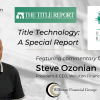
In the last three years, a new class of homeowner entered our business. They are the largest in history, and they represent the beginning of something much more important to come.
Institutional investment in single-family rentals, the SFR industry, began as a purely opportunistic pursuit. The housing crisis captured Wall Street’s attention, and the trailblazers came in force to acquire distressed property at a discount. This is very similar to the way another generation of trailblazers dove into the commercial real estate market in the late ’80s and early ’90s, when the savings-and-loan crisis created a massive opportunity to buy commercial property at distressed prices.
What came next, after the dust settled, appears to be happening again now. When commercial real estate emerged in the mid-1990s from its crisis, half a trillion dollars flowed into the asset classes of office, retail, multifamily and industrial real estate through real estate investment trusts and other, more conservative investment funds. The trail became a smoothly paved highway and opened for more traffic.
Think of it this way: Trailblazers need strong motivation to hack through a dense forest. Moderate returns aren’t enough of an incentive for them to do the hard work of figuring out the asset class. They have to gather the data, set the standards, engineer the professional management processes, build the technology and take the risks. But once all of that hard work is finished, others can follow at a considerably reduced risk.
Now our path has been cleared, and the next wave of investment capital is lining up. Not for 15 to 20 percent returns on distressed property, but for more conservative 7 to 8 percent returns, which quality houses in healthy communities can easily create.
According to Morgan Stanley, which produces some of the best research in this sector, $100 billion will enter the single-family rental market over the next decade. We are seeing those institutional investors starting to show up now, and they are showing signs of taking a different, quality-driven approach.
In other words, we’re seeing a shift from lower-priced housing in marginal neighborhoods to higher-quality homes in the highest-quality markets. It’s not about deals anymore. The long-term winners will build rental portfolios of the best product and attract the best customers.
Why? Because renters like nice houses, too.
Greg Rand is CEO of OwnAmerica, a national network of real estate brokerage companies that represent housing as an asset class.
The post Is real estate missing a $100 billion opportunity? appeared first on WFG National Title Insurance Company.






